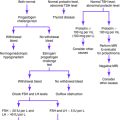Chapter 39 VAGINAL BLEEDING IN EARLY PREGNANCY
Vaginal bleeding in early pregnancy is common. The main differential diagnosis is threatened abortion, spontaneous abortion, ectopic pregnancy, and molar pregnancy.
Key Historical Features
✓ Obstetric and gynecologic history
Key Physical Findings
✓ Vital signs, including orthostatic assessments
✓ Evidence of a bleeding disorder, such as bruising
✓ Gynecologic/obstetric examination
✓ Abdominal examination for tenderness, rebound, or guarding (the presence of peritoneal signs is suspect for ectopic pregnancy)
✓ Rectal examination to note the presence of any hemorrhoids
Suggested Work-Up
| Urine pregnancy test | To confirm pregnancy |
| Transvaginal ultrasonography | To determine whether there is a viable intrauterine pregnancy and to evaluate for an adnexal mass or free fluid in the cul-de-sac (a molar pregnancy has a “snowstorm” appearance on ultrasonography) |
| Blood type and screen | To determine the patient’s Rh status, because anti–D immune globulin should be given if the patient is Rh negative |
Additional Work-Up
| Quantitative β–human chorionic gonadotropin (β-hCG) measurement | Useful if an intrauterine pregnancy is not seen on ultrasound examination, in order to determine the risk of an ectopic pregnancy |
| Serial β-hCG measurements are useful for determining a patient’s risk of spontaneous abortion | |
| A gestational sac should be seen on transvaginal ultrasonogram if the β-hCG measurement is 2000 IU/L or higher; if a gestational sac is not seen, an ectopic pregnancy should be suspected | |
| β-hCG measurements should double over 48 hours in a viable pregnancy | |
| Complete blood cell count | To determine whether the patient is anemic; also useful if the patient is febrile, to determine the white blood cell count |
| Wet-mount preparation and potassium hydroxide (KOH) microscopy of vaginal discharge | To evaluate for vaginitis |
| Cervical culture for Neisseria gonorrhea and Chlamydia trachomatis | If patient is at risk for a sexually transmitted disease |
| Pap smear | If cervical dysplasia is suspected |
Beckmann CRB, Ling FW, Smith RP, et al, editors. Obstetrics and Gynecology, 5th, Philadelphia: Lippincott Williams & Wilkins, 2006.
Chamberlain G. Vaginal bleeding in early pregnancy—II. BMJ. 1991;302:1195-1197.
Coppola PT, Coppola M. Vaginal bleeding in the first 20 weeks of pregnancy. Emerg Med Clin North Am. 2003;21:667-677.
Della-Giustina D, Denny M. Ectopic pregnancy. Emerg Med Clin North Am. 2003;21:565-584.
Farquhar CM. Ectopic pregnancy. Lancet. 2005;366:583-591.
Griebel CP, Halvorsen J, Golemon TB, et al. Management of spontaneous abortion. Am Fam Physician. 2005;72:1243-1250.
McKennett M, Fullerton JT. Vaginal bleeding in pregnancy. Am Fam Physician. 1995;51:639-646.





